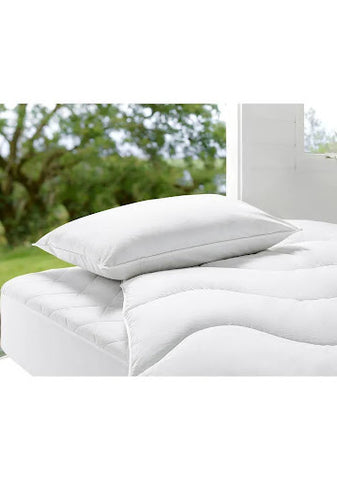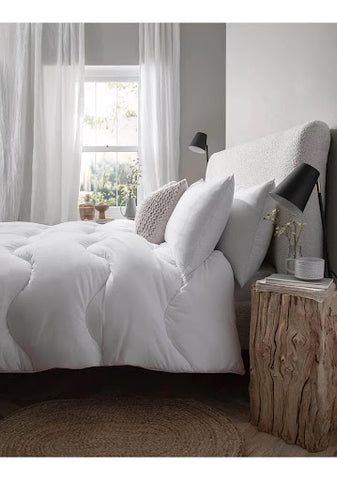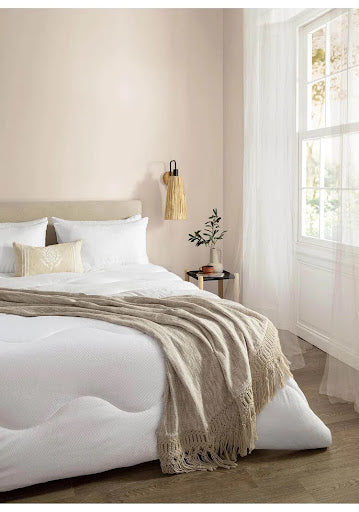To find that perfect balance between being too warm and too cold, you need to choose the right tog rating for your duvet. With the right tog for summer and winter, you can say goodbye to restless, uncomfortable nights and embrace a bed that's just right every time.
Join us in exploring the science of tog ratings and duvet fillings, where the ultimate goal is to make sure you have a good night every night, no matter the weather outside.
What is a Tog in a Duvet?
A tog is a unit of measurement used to determine the thermal insulation of a duvet or comforter. Essentially, the tog rating indicates how warm and cosy a duvet will be, making it an important factor to consider when choosing the right bedding for your home.
The higher the tog rating, the warmer the duvet will be. For example, a duvet with a tog rating of 4.5 would be lightweight and ideal for warmer climates or summer use, while a duvet with a tog rating of 9 or higher would be better suited for cold winter nights.
Understanding the tog rating of a duvet is essential for ensuring that you stay comfortable and sleep well. If you tend to feel cold at night, opt for a duvet with a higher tog rating, while those who easily overheat may prefer a lower tog rating.
It's also important to consider the material and filling of the duvet. A duvet with a natural down filling may have a higher tog rating but provide more insulation than a synthetic materials duvet with the same tog rating.
What Tog Duvet Should I Buy?

The tog rating of the duvet you should buy depends largely on your personal preference, the climate you live in, and how warm or cool you keep your home. Here's a general guide:
If you tend to get hot while sleeping, opt for a lower tog rating. Conversely, if you often feel cold, choose a higher tog.
In warmer months or if you live in a generally warm climate, a lower tog rating, typically between 1.0 and 7.0, is advisable to keep you comfortable without overheating. For colder months or cooler climates like Ireland, a higher tog rating, usually from 10.5 to 13.5, is preferred to retain warmth.
If you prefer not to switch duvets with the seasons, a mid-range tog rating of about 7.0 to 10.5 can be a good compromise.
A lower tog rating (around 4.0 to 7.0) is recommended for young children, especially toddlers and babies. Elderly or health conditions: If you're elderly or have certain health conditions, you might need a higher tog for extra warmth.
Consider how warm or cool your house is kept. Well-insulated homes with central heating may only require a lower or mid-range tog.
Remember, the best choice is subjective and varies based on individual comfort preferences and circumstances. Some people also opt for all-season duvets, which come with two parts that can be used separately or combined for different times of the year.
Duvet Tog Chart
To help you quickly choose a duvet tog rating for your needs, here is our easy-to-follow Duvet Tog Guide:
|
Season
|
Duvet Tog Ratings
|
Experience
|
|
Summer duvet
|
2.5 tog to 4.5 tog
|
For warm summer nights
|
|
Spring / Autumn duvet
|
7 tog to 10.5 tog
|
For cooler nights
|
|
Winter duvet
|
9 tog to 13.5 tog
|
For cold winter nights
|
|
All seasons duvet
|
4.5 tog + 9 tog
|
For all year
|
What Tog is a Winter Duvet?
A winter duvet tog typically has a rating of around 9 or higher, making it ideal for the colder temperatures of the winter season. The higher tog rating provides a thick, warm layer of insulation to help you stay comfortable and cosy throughout the night.
When shopping for a winter duvet, consider your warmth and climate preference. If you tend to get cold easily or live in a particularly cold area, opt for a duvet with a higher tog rating. On the other hand, if you live in a milder climate or tend to run hot while sleeping, a lower tog rating may be sufficient.
Natural materials like down and wool are excellent insulators and can provide superior warmth, while synthetic fillings like polyester are popular for their affordability and hypoallergenic properties.
What Tog is a Summer Duvet?
A summer duvet tog usually has a lower rating to keep you cool and comfortable during the warmer months. A typical summer duvet will have a tog rating of around 4.5 to 7.5. This rating provides just enough insulation to keep you comfortable on those warm summer nights without causing you to overheat. The lower tog rating allows for better breathability and airflow, helping to regulate your body temperature as you sleep.
When selecting a summer duvet, consider the tog rating and the materials used. Natural materials such as cotton, silk, or bamboo are ideal for summer duvets as they are lightweight, breathable, and help wick away moisture. These materials can help you stay cool and comfortable on even the hottest nights.
Summer vs Winter Tog

Choosing between a summer or winter tog duvet depends on a few key factors:
- If you live in Ireland with distinct seasonal temperature changes, you might need both types of duvet: a summer tog for warmer months and a winter tog for colder periods.
- Some people naturally sleep hot or cold. If you tend to overheat at night, a lighter summer tog might be preferable even in cooler months. Conversely, winter tog might be better year-round if you're always cold.
- Consider how warm or cool your home is maintained. A heavy winter tog might not be necessary if you have effective heating in winter.
- Layering can be a practical approach. A medium tog duvet with additional blankets for colder nights offers flexibility.
- Duvet covers and sheets impact the overall warmth and comfort of your bedding, with breathable materials like cotton enhancing the cooling effect of lower-tog duvets and warmer fabrics like flannel adding cosiness to higher-tog duvets.
If you're still unsure, a medium-tog duvet could be a versatile choice, balancing warmth and breathability for most of the year.
Where to Buy Duvet in Ireland?
At Shaws, selecting the perfect duvet is serious business, where every detail from material to size and warmth level is meticulously considered to match your ideal comfort. Our extensive collection caters to diverse preferences, ensuring customers find exactly what they need.
Specialised bedding expertise is at the heart of Shaws, ensuring personalised solutions for everyone. And for our online shoppers, the journey to the perfect duvet is seamless, thanks to our user-friendly digital platform. You can easily browse through a wide range of options, filter by tog ratings for the perfect warmth, read detailed product descriptions and reviews, compare prices, and effortlessly place an order – all from the comfort of your home.
Discover the essence of comfort and quality with Shaws in Ireland, where your perfect duvet awaits for a good night’s sleep.


